Clinical and mechanical outcomes in isolated anterior cruciate ligament reconstruction vs additional lateral extra-articular tenodesis or anterolateral ligament reconstruction
INTRODUCTION
Rupture of the anterior cruciate ligament (ACL) is one of the most common sporting injuries affecting the knee joint.In the United Kingdom,the National Ligament Registry has noted over 15304 cases of ACL rupture between 2012 and 2019[1].
He had been travelling for many days, and had left his fatherland behind him, when close to the road he came upon a huge tree, and on its topmost bough11 an eagle was sitting shaking the branches with all his might
Those with symptomatic instability have traditionally been treated with arthroscopic ACL reconstruction (ACLR).Numerous studies demonstrate excellent short term functional outcomes however some questions remain regarding this treatment[2,3].ACLR has demonstrated to be effective in restoring translational stability,however the capacity to restore rotational stability is limited[4,5].Patient reported outcome measures tend to correlate with improvements in translational rather than rotational stability.Moreover,rotational instability has been implicated in the development of knee osteoarthritis.Despite technical improvements,such as single or double bundle reconstructions and more accurate tunnel placement,the rates of positive pivot-shift test remain unacceptably high.
The role of the anterolateral soft tissue restraints (including the anterolateral ligament (ALL)) in rotational stability are increasingly being recognized[6,7].Historically,several anterolateral extra articular procedures (AEAP) had been developed to tackle anterolateral instability,including lateral extra-articular tenodesis (LET),originally described by Lemaire[8].There is conflicting evidence in the literature surrounding LET.Some studies have shown that LET provides no additional benefit when performed in combination with ACLR,compared to isolated ACLR[9,10].Other studies have found that in high-risk patients,such as those with additional laxity,LET results in reduced graft rupture and reduces rotatory laxity[11,12].More recently,with the newfound understanding of biomechanics and anatomy,another procedure,anterolateral ligament reconstruction (ALLR) has been developed.Biomechanical studies have shown variable restoration of knee kinematics in addition to concerns that the technique may lead to over constraint of the lateral compartment;thus,actually accelerating degenerative changes[13,14].
The aim of this systematic review and meta-analysis was to firstly compare the clinical effectiveness of ACLR combined with LET or ALLR,to ACLR alone.Secondly,to compare the clinical and mechanical outcomes of the two AEAPs discussed.
MATERIALS AND METHODS
Database and inclusion criteria
A systematic review in accordance with the Preferred Reporting Items for Systematic Reviews and Meta-Analysis (PRSIMA) was conducted[15].Using the PICO model,inclusion and exclusion criteria were set[16].Only randomized control trials (RCTs) cohort,cross-sectional studies and case control studies were included.Reviews,conference abstracts,case series,case reports and editorials were excluded.Only studies which investigated either ACL reconstruction with additional ALLR or LET were included.Studies which investigated revision ACLR were excluded.The references of the final studies were checked for any additional studies that would meet the inclusion criteria.
A literature search was carried out by A.N.Four databases were searched for studies which were relevant to this systematic review: MEDLINE (2000 to Week 4 November 2021),EMBASE (2000 to 29 November 2021),Cochrane library (2000 to November 2021) and clinical trials.gov (2000 to November 2021).The(https://www.referencecitationanalysis.com/) software was also utilized to identify any additional studies.
A comprehensive strategy was developed,upon which the databases were searched.This was designed on the basis of the guidelines provided by the Cochrane Highly Sensitive Search Strategy[17].This included but was not restricted to the following MeSH terms: “Anterior Cruciate Ligament”,or “tenodesis” or “iliotibial band” or “extra articular” and “reconstruction” or “Anterior Cruciate Ligament Reconstruction”.Full MeSH terms used can be found in Appendix 1 (Supplementary material).Onlystudies were included.In addition,it was decided that only studies from 2000 onwards should be included,since studies before this time could be considered outdated,considering the novel developments in orthopaedic surgery.The authors only wanted to examine novel techniques which are currently in use in clinical practice.The overall results of the comprehensive search are shown in Figure 1.The structure of this table was incorporated from Page[18].

Quality assessment
All studies included in this review were independently appraised by two authors A.N and J.M.The critical appraisal was conducted by the Critical Appraisal Skills Programme (CASP) checklists for randomized controlled trials,cohort studies and case control studies[19].The appraisals for each RCT can be found in Table 1 and appraisals for cohort studies can be found in Table 2.One study was of case control study design.This was assessed accordingly by the CASP checklist for case control studies.The questions in each of the checklists are listed in Appendix 2 (Supplementary material).Any disagreements were solved by discussion.
Anterior cruciate ligament (ACL) reconstruction surgery has shown excellent outcomes,however the restoration of rotational stability remains limited.The role of the reconstruction of the lateral soft tissue restraints or the supplement of the ACL reconstruction with a lateral extra-articular tenodesis have gain popularity and they are now routinely procedures following an ACL reconstruction.
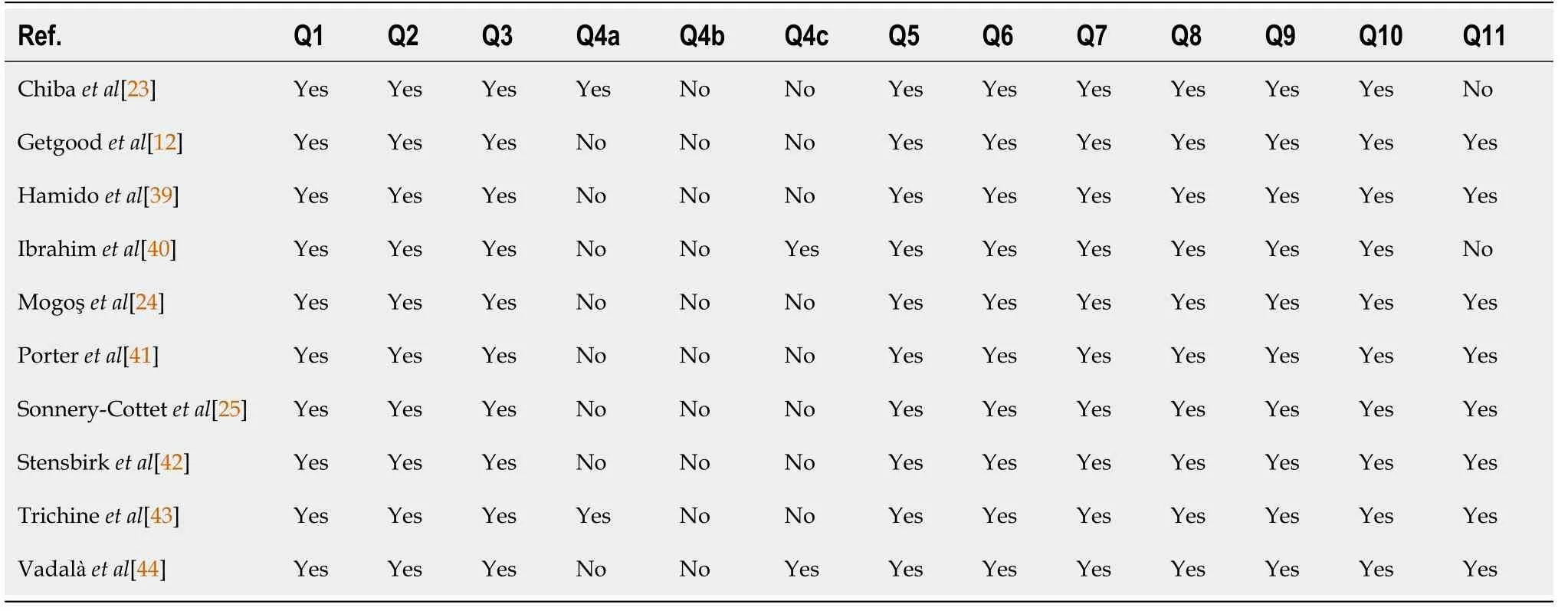
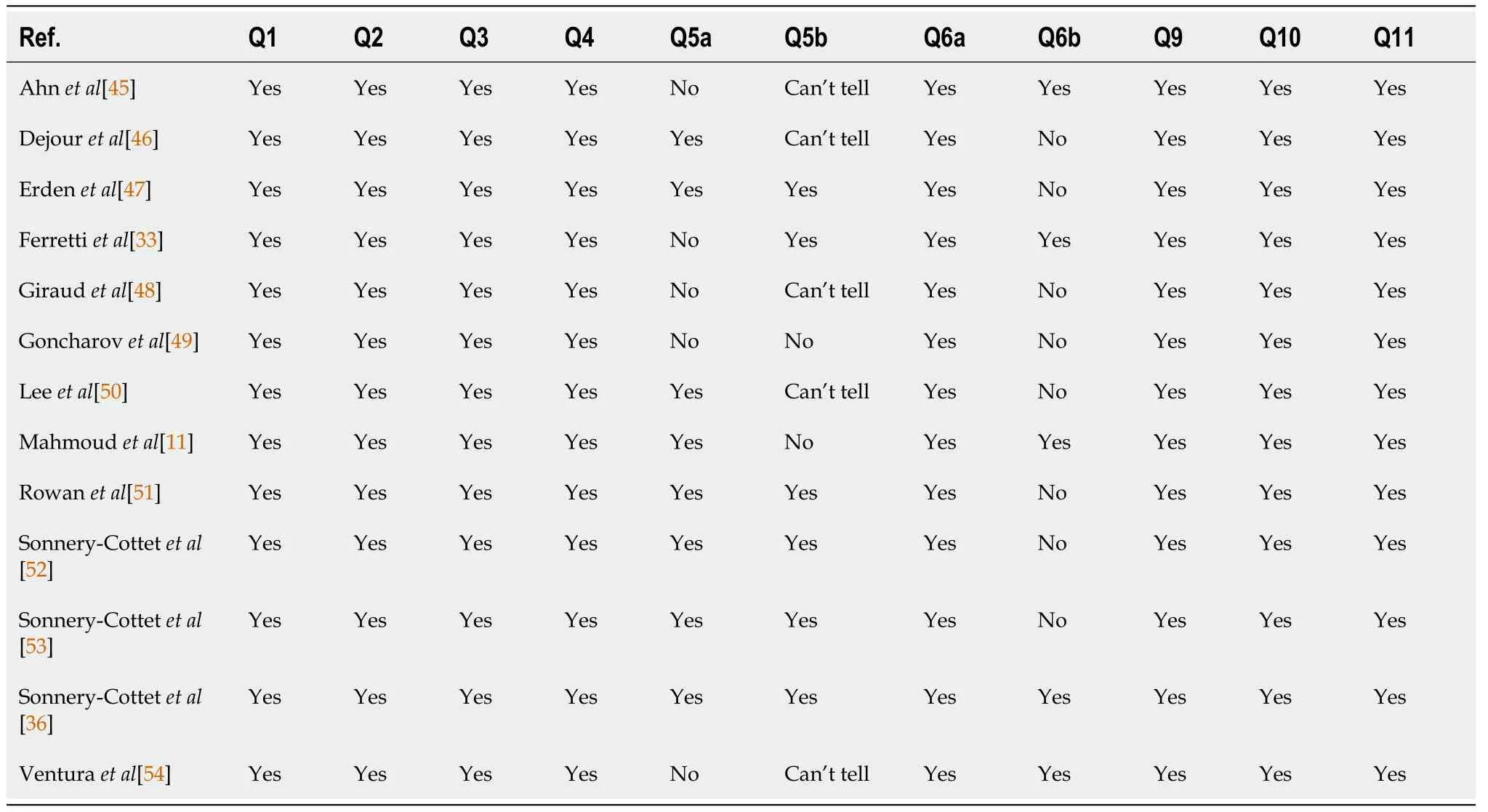
Data extraction
The following study characteristics were extracted from each study after full text analysis: study design,number of patients included in the study,country of origin,mean follow up time,type of AEAP investigated,outcomes measured,and year published.
Statistical analysis
All statistical analysis was conducted using JASP (version 0.16,University of Amsterdam).A restricted maximum likelihood random effects model was used to generate a pooled estimate of the odds ratio of an “event” for analysis of post-operative pivot shift test and International Knee Documentation Committee (IKDC) score.Itest was used as a measure of between study heterogeneity.The pivot shift test is a validated tool to assess rotatory instability,is highly sensitive and specific for ACL rupture and the presence of a positive results does correlate well with clinical outcomes[20].The IKDC score has also been shown to have a high criterion validity in assessment of treatment outcome and is widely used[21].As these two measures could be recorded as categorical variables they were selected for metaanalysis.For the purpose of the analysis and in line with previous published literature we considered a pivot shift test grades 1,2 or 3 was defined as an event[22].For the IKDC score an overall grade C (abnormal) or D (severely abnormal) was considered an event.Statistical analysis on categorical data was performed using cross tabulation and Chi squared testing for categorical data,or Fisher’s exact test if the sample size did not permit Chi Squared testing.Avalue of <0.05 was considered statistically significant.
RESULTS
Study characteristics
The most common mechanical outcome measured in the studies included in this review was the pivot shift test scores.Other mechanical outcomes investigated by studies included;KT 1000/-2000 arthrometry side to side laxity,anterior tibial translation,Lachmann test,Rolimeter test scores and radiological medial and lateral compartment laxities.Analysis of instability using the latter techniques mentioned was not conducted due to the inconsistent use of these scoring systems between studies,and the small number of studies which employed each.The combined analyses of pivot shift test scores demonstrated that use of AEAP in addition to ACLR results in better pivot shift test scores,compared to ACLR alone.However,upon comparison of the ACLR + LETACLR + ALLR there is no statistically significant difference in mechanical outcomes between these two groups.This suggests that though ACLR + AEAPs confers greater rotational stability than ACLR alone,neither technique confers more rotational stability than the other.
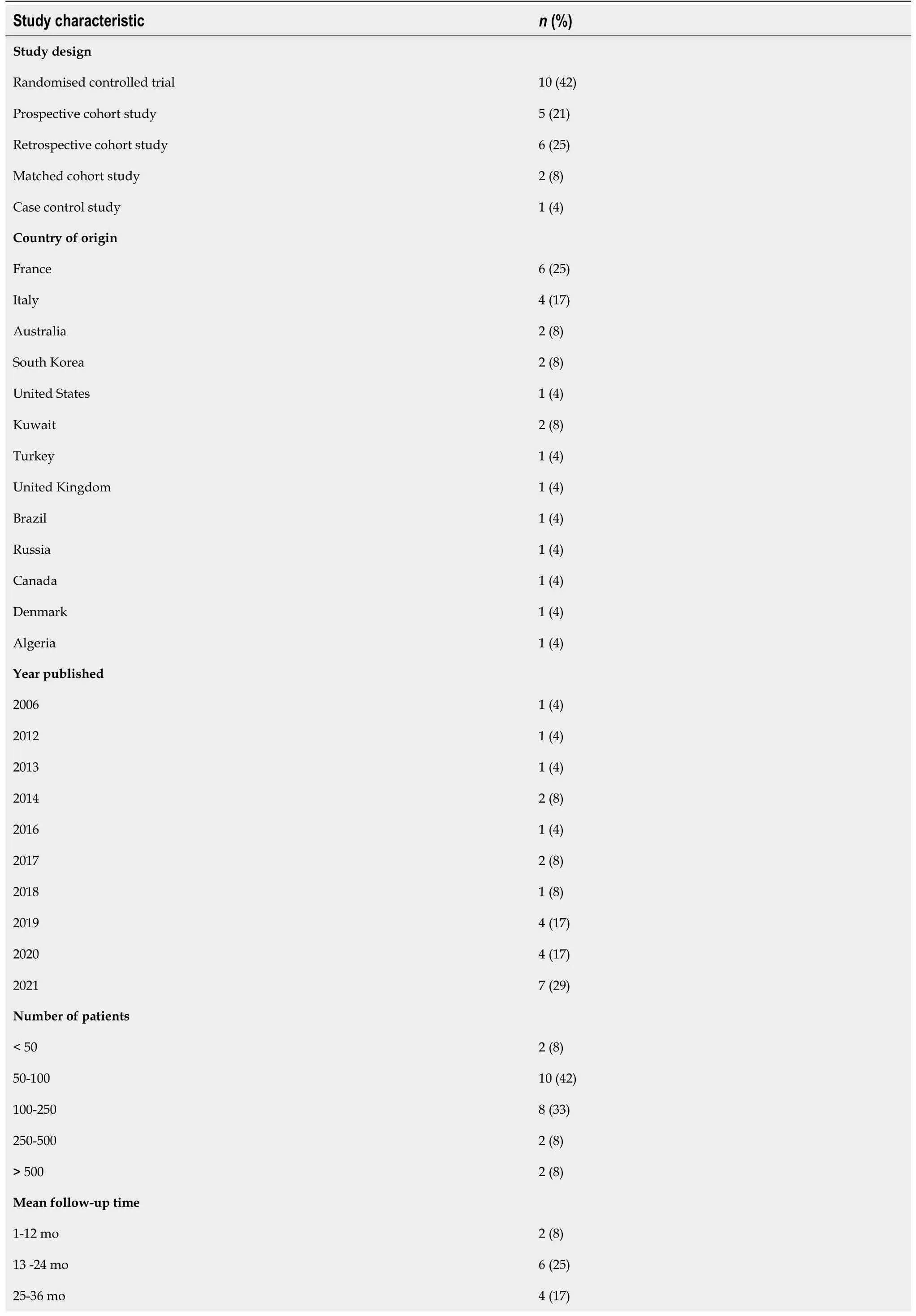

Thirteen studies compared ACLR to ACLR + LET.The remaining 11 were studies which compared ACLR to ACLR + ALLR.
The most common range of follow up times was 37-60 mo (= 7).Six studies had a follow up time between 13 and 24 mo.Only 5 of studies used follow up times greater than 60 mo.Thirteen of the studies included in this review,had a follow up duration time less than 37 mo.
The addition of AEAPs to primary ACLR appears to result in improved rates of rotatory stability when comparing pivot shift test results,however it remains unclear whether this translates to improved functional outcomes.Our results suggest that surgeons should consider offering AEAPs in patients with rotatory instability following ACL rupture.More work is needed to identify patients who would benefit most.Both techniques appear to result in reduced rates of graft failure,compared to isolated ACLR,though ALLR has lower re-rupture rates than LET.Mechanical outcomes appear equivocal between the two AEAPs.A randomized controlled trial comparing the two techniques would be of value.
Sometimes I really doubt whether there is love between my parents. Every day they are very busy trying to earn money in order to pay the high tuition1 for my brother and me. They don t act in the romantic ways that I read in books or I see on TV. In their opinion, I love you is too luxurious2 for them to say. Sending flowers to each other on Valentine s Day is even more out of the question. Finally my father has a bad temper. When he s very tired from the hard work, it is easy for him to lose his temper.
Clinical outcomes
29. Greatly fatigued the wearer: However, no such difficulties seem to trouble Little Thumb once he has gained possession of the boots.Return to place in story.
But as I have plighted34 my word to another maiden35, you will see yourself, and so will this young woman, that I cannot go back from my word, and be faithless to her whom I love
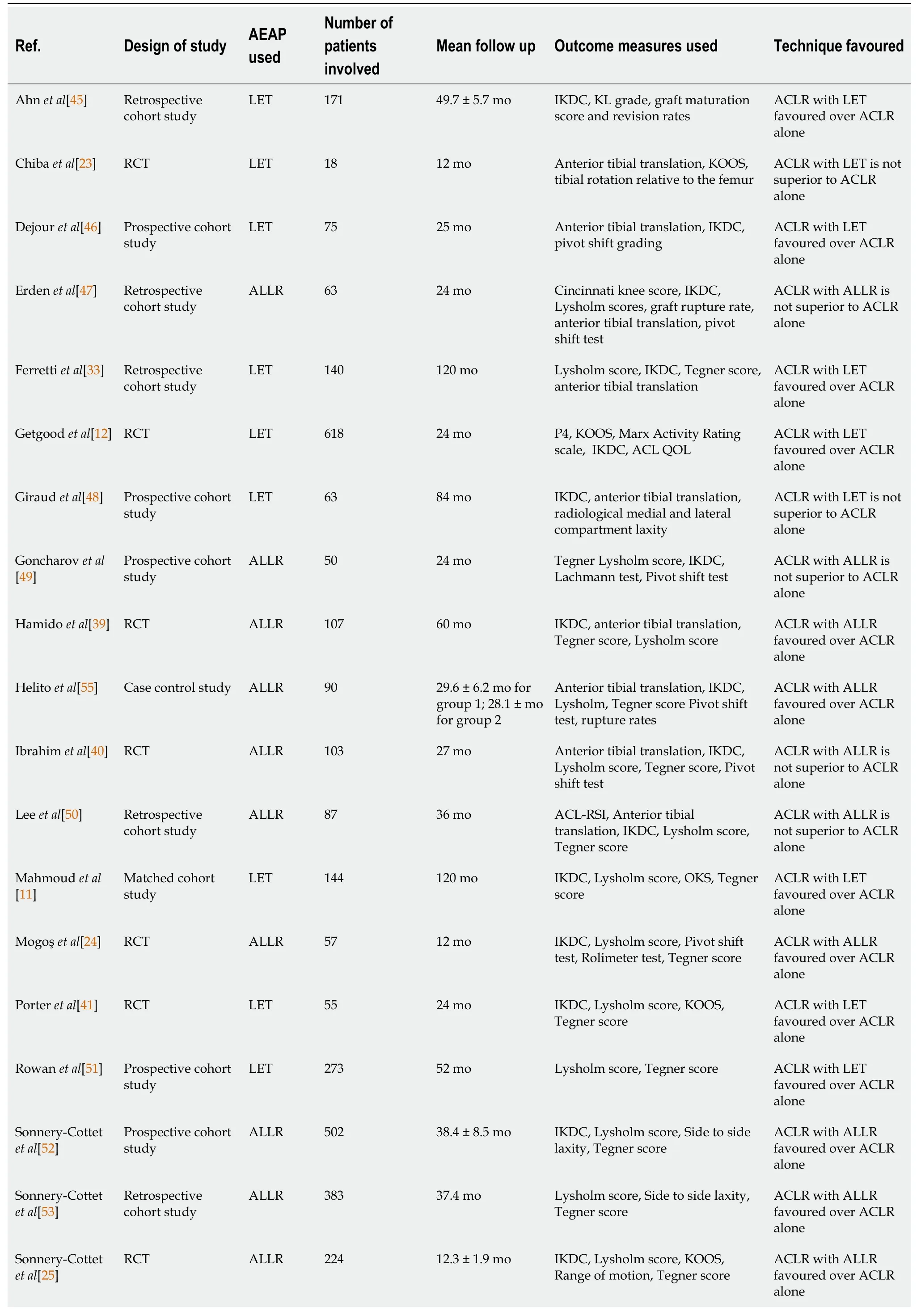

Forest plots were created to analyze clinical and mechanical outcomes most utilized by all studies in ACLR only patient groupsACLR + AEAP patient groups (Figure 2).
But I tell you what. If you want to buy five of them, I won t complain too loudly about that. You can t expect me to give up all my wonderful sculptures to some stranger who left a 60 foot crane in my back yard.
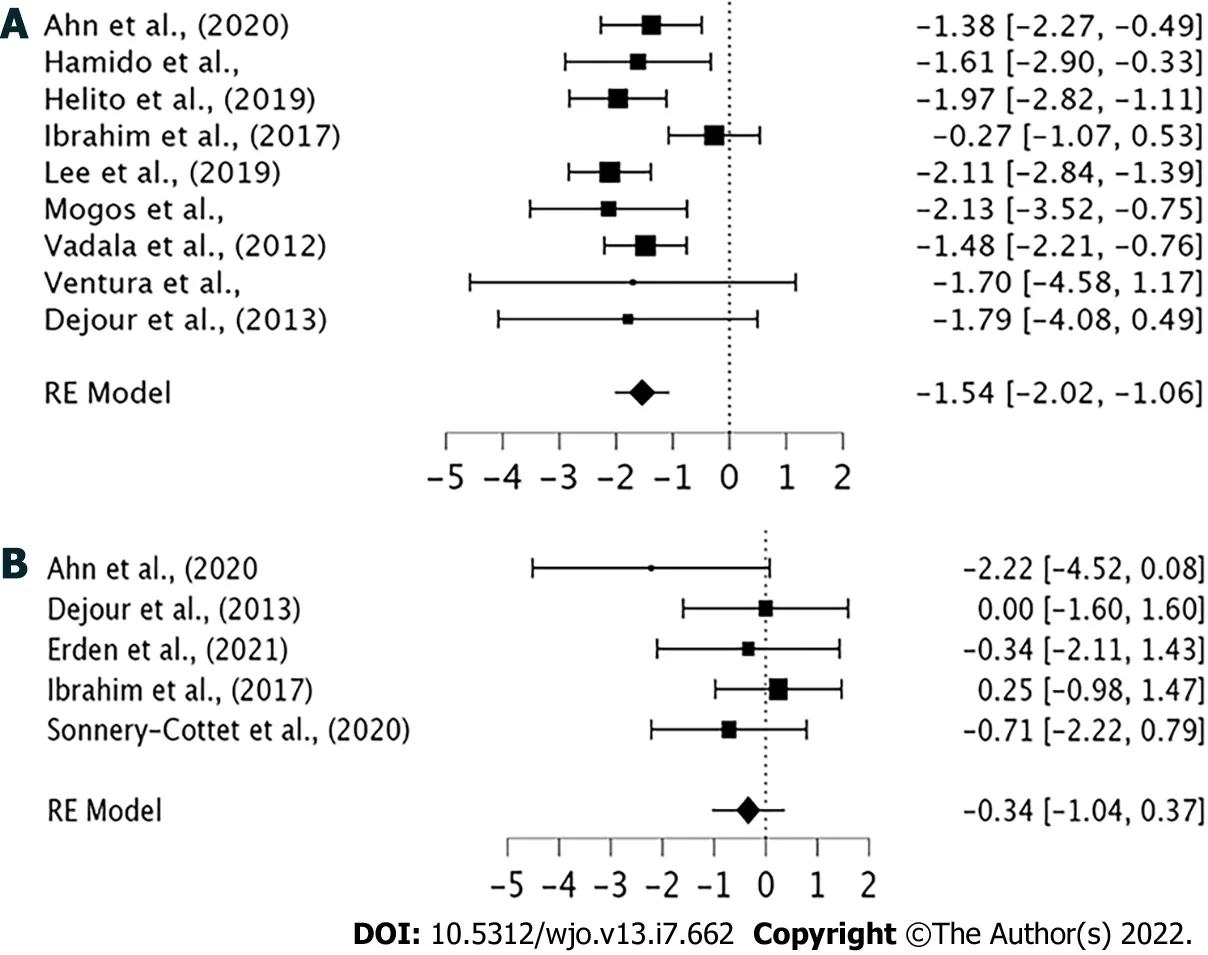
Figure 2A shows analysis of all nine studies which used pivot shift test scores to analyze mechanical outcomes in ACLR only patient groupsACLR + AEAP patient groups.The nine studies that could be used in analysis encompassed 961 knees.Six of the nine studies demonstrated a statistically significant difference in pivot shift test scores between ACLR only patient groups and ACLR + AEAP patient groups.The pooled estimates of odds ratio were -1.54 (95%CI -2.02 to -1.06,<0.001) in favor of ACLR + AEAP.This suggests that the addition of AEAP to ACLR results in statistically significantly better pivot shift test scores and therefore greater rotational stability.
Comparison of clinical outcomes between ACLR only and ACLR + AEAP patient groups was conducted using IKDC scores.Five studies were eligible for pooled analysis,which encompassed 878 knees (Figure 2B).There was no statistically significant difference in IKDC scores between the ACLR only and ACLR + AEAP patient groups in any of the five studies.The pooled estimates of log ratio were -0.34 (95%CI -1.04 to 0.37).This demonstrated that the addition of AEAP to ACLR did not result in any statistically significant improvement in IKDC clinical scores (Z = -0.938,= 0.348).
The king and queen were very anxious to bring their children up well, and the young prince and princess were taught everything likely to make them clever and accomplished3
The girl accepted her offer with joy, and she was at once set to work in a corner of the kitchen,15 where all the farm servants came and made fun of her, and the ass’s skin in which she was wrapped. But by-and-by they got so used to the sight of it that it ceased to amuse them, and she worked so hard and so well, that her mistress grew quite fond of her. And she was so clever at keeping sheep and herding24 turkeys that you would have thought she had done nothing else during her whole life !
Following statistical analysis of ACLR alone vs ACLR + AEAP,analysis was then conducted to determine whether there was a difference in clinical and mechanical outcomes between the two AEAPs included: LET and ALLR.The chi squared test was performed which demonstrated that there was no statistically significant difference in pivot shift tests between ACLR + LET and ACLR + ALLR groups (P = 0.39).The chi squared test also showed that there was no statistically significant difference in IKDC scores between ACLR + LET and ACLR + ALLR groups (= 0.90).This indicates that there are no differences in rotational stability or clinical outcomes with regards to the specific AEAP (LET or ALLR) utilized with ACLR.
ACL re rupture rates were also compared between ACLR + LET and ACLR + ALLR techniques.There was a statistically significant difference between techniques,with a 1.14% re rupture rate in ACLR + ALLR,and 4.03% re rupture rate in ACLR + LET (= 0.015).This indicated that ACL re-rupture rates were higher in ACLR + LET compared ACLR + ALLR.The re-rupture rate for ACLR alone across all studies was 12.59%,significantly higher than when augmented with either ALLR or LET (<0.0001 for both groups).
Another limitation was that only studies conducted after 2000 were included in this review.The reason for this was we wanted to examine novel techniques that were currently in use.However,we acknowledge that this may bias the outcomes of this review.Moreover,this analysis did not search the grey literature,and so there are potentially other studies which are relevant but were not included in this review.
DISCUSSION
ACLR has shown excellent results in restoring translational stability.The capacity to restore rotational stability,however,remains an issue.This review has focused on the clinical and mechanical outcomes which follow treatment of primary ACL injuries with AEAPs,in addition to ACLR.The supplementation of an AEAP does appear to improve mechanical outcomes compared to ACLR alone.This suggests that patients with rotatory instability should be offered an AEAP with the ACLR reconstruction.However,there appears to be no difference in mechanical outcomes between AEAPs,which suggests that either LET or ALLR can be used with ACLR to reduce rotational instability.Our results did not show any benefits in clinical outcomes with the addition of AEAP to ACLR.An important consideration to note is that,since we have demonstrated there may not necessarily be direct clinical benefit in all patients,the challenge will be to identify patients where the risk-benefit analysis would favour AEAP.Both LET and ALLR can cause issue over constraint with poor graft placement which may worsen patient outcomes.
Table 3 displays the study characteristics of all 24 studies encompassed in this review.Most studies were cohort studies,with 6 retrospective,5 prospective and 2 matched cohort studies (= 2).Ten studies were RCTs.One study was a case control study.
“Mom,” I said as patiently as I could, “you have to learn to ride a bike if you want to ride with me in the Bike-a-Thon, and it’s only two weeks away.”
Studies have shown that poorer pivot shift test scores correlate to poorer clinical outcomes and patient satisfaction following ACLR[26,27].Moreover,recent cadaveric studies have demonstrated that ACLR alone does not restore normal knee kinematics,and that an AEAP is required to restore anterior tibial translation and tibiofemoral motion[28,29].
The most common clinical outcome utilized by studies was IKDC scores.Other clinical scores used were: Lysholm score,Tegner score,KOOS score and Cincinnati knee score.Analysis of clinical outcomes,using these latter scoring systems was not conducted due to the small number of studies which employed each one.The pooled analyses of the IKDC scores demonstrated that use of an AEAP with ACLR does not result in any statistical improvements in outcomes.There are several possibilities for this.There may be a ceiling effect to IKDC score making it insensitive in detecting improvements in rotatory stability.We also utilized overall scores and dichotomized the outcomes;this may have also reduced the sensitivity of the analysis.
When directly comparing ALLR with LET,re-rupture rates were higher with LET (1.14%4.03%,= 0.015).The re-rupture rate for ACLR alone across all studies was 12.59%,significantly higher than when augmented with either ALLR or LET (<0.0001 for both groups).Studies that evaluated ACLR + LET were then compared with studies which assessed ACLR + ALLR.Direct analysis shows that ACL re-rupture rates were higher in ACLR + LET than with ACLR + ALLR.This suggests that LET techniques have a higher ACL re rupture rate.However,existing literature suggests that ACL rerupture rates are higher in ACLR alone compared with ACLR with AEAPs.A study conducted by Marom[30],found that the addition of LET to ACLR reduces stress on the graft,by transferring loads to the LET.In addition,this reduces anterior tibial translation when pivoting loads are applied[30].The reduced strain on the graft would explain why AEAPs lead to reduced re-rupture rates.
There were no studies in the literature which directly compared LET with ALLR.This is understandable given the recent growing interest in ALLR.Certainly,randomized controlled trials are required to assess the two techniques.As ALLR becomes more common practice in the future this will likely become feasible.Ra[31] did compare the studies using ACLR + LET with ACLR + ALLR in 2020.Their meta-analysis of non-comparative could not demonstrate a significant difference in rotational stability between ALLR and LET.
There are risks associated with LET procedure.LET is a non-anatomical reconstructive procedure potentially giving it inherent disadvantages over ALLR.While there is evidence to suggest it does help restore normal knee kinematics following ACL injury,there are concerns in the literature that the knee may become over constrained[28,32].Biomechanical studies have investigated the effects of over constraining[28,32].Several studies reporting on LET have recommended the graft be fixed with the knee in extension.This could interfere with the “screw home” mechanism of the knee by acting as a restraint to tibial internal rotation[28].Tibiofemoral contact pressures could increase,thus accelerating the development of osteoarthritis.In addition,this would increase tensile forces the knee is subjected to through the action of the extensor mechanism,potentially increasing the risk of graft rupture.This could explain why our date shows increased risk of graft rupture in LET compared to ALLR.However,these same studies have noted that if the graft is tensioned in neutral,risk of overstraining decreases and there is little risk of accelerated osteoarthritis[28,32].The study by Ferretti[33] demonstrated that at a 10 year follow up,ACLR with LET did not result in increased osteoarthritic rates.This perhaps underscores the importance of sound surgical technique,as more experience is gained with LET,we may see improved outcomes with respect to over constraining of the lateral compartment.Longer term follow-up studies are needed to examine the risk of osteoarthritis further.
Similar concerns have been voiced for ALLR techniques.A recent cadaveric study demonstrated that over constraining is possible with ALLR[34].A separate study by Neri[35] illustrated that ALLR does not lead to increased contact pressures in the lateral compartment.Sonnery-Cottet[36] commented that they considered the reason that ALLR avoids over constraint is because the grafts are fixed such that they behave an isometrically.In their technique they identify an isometric point close to the lateral femoral condyle.This point is drilled in an outside-in technique.The tunnel is used for both the ACL reconstruction and ALLR.Once the ACL reconstruction is completed the remaining strand of the graft is used to complete the ALLR by tunnelling it under the ilio-tibial band but superficial to the fibular collateral ligament.The graft is then passed though the tibial tunnel and then brought back proximally towards the femur.This creates an inverted Y shaped acting as a double bundle graft.Whether this behaves isometrically has yet to be proven.
LET is also associated with donor site cosmesis problems[37,38].It is possible this can be overcome with new minimally invasive techniques which involve tunnelling the grafts deeper.
The strengths of this review include the breadth of studies included.Studies from 13 countries were included in this review.Multiple languages were included,meaning we were less likely to miss relevant datasets.To the best of our knowledge this first meta-analysis to include randomized control studies and case-control studies ALLR with ACLR and the largest to include ALLR.
There were limitations to this review.There was significant heterogeneity amongst the studies included in this review,and thus several studies could not be included in the pooled analysis.This is a common problem encountered when attempting to conduct a meta-analysis.Moreover,there was a wide variation in the techniques used for each procedure of ACLR,ALLR and LET.Regarding extra articular procedures,no consensus has been reached regarding the optimal graft type,location of fixation or the fixation angle.
Table 4 summarizes the main characteristics of all the studies included in this systematic review.
I arrived a couple of days later on a chilly5 autumn morning and spied a frost-covered paper bag on the back steps. With my trowel and bone meal in hand, I set off in search of just the right place to plant.
There were also limitations of the studies included in this review.The mean follow duration was 50.8 mo across all studies.The mean follow-up for LET studies was 62.2 mo,compared with 36.8 mo for ALLR.As a result,these studies could not effectively compare rates of osteoarthritis between techniques.Though as previously mentioned,Ferretti[33] which conducted a 10-year follow up study,found no increases in osteoarthritic rates with ACLR with LET.Since ALLR is a relatively new technique,it is possible that more studies with longer follow up times may be available over the coming years.While it was recognized the reliably of the meta-analysis would be improved by only including studies with longer follow up (> 24 mo).We did include three studies that had a mean follow up period of approximately 12 mo[23-25].It was the consensus of the authors that the large number of patients and the overall quality of the studies meant the data present in these two studies would add robustness to the meta-analysis as such they were included.The authors also felt it would be of value to the reader for the review to be more comprehensive to make the reader aware of the breadth of evidence available on the subject matter.This strengthened the consensus for the inclusion of these studies.
CONCLUSION
Upon critical appraisal of the studies included in this review,using the appropriate CASP tools,it was established that very few RCTs included in this review were blinded.This was however,recognized by most studies,who considered it unfeasible to blind the patients,and impractical to blind the surgeons.Some of the cohort studies included in this review did not account for or did not mention confounding variables,which could have led to unforeseen biases.Three of the studies also were deemed to have short follow up (<24 mo).While it was recognized the reliably of the meta-analysis would be improved by only including studies with longer follow up (> 24 mo),it was the consensus of the authors that the large number of patients and the overall quality of the studies meant the data present in these three studies would add robustness to the meta-analysis as such they were included[23-25].Overall,the quality of all studies included in this review was high.Tables 1 and 2 demonstrate the full methodological quality assessment of the included studies.
ARTICLE HIGHLIGHTS
Research background
If your majesty goes out there alone, fasting, before sunrise, and takes the middle one of the three buds, and eats it, then in six months you will bring a princess into the world
Research motivation
The research motivation of this systematic review and meta-analysis was to clarify how ACL reconstruction surgery combined with lateral extra-articular tenodesis (LET) or anterolateral ligament reconstruction (ALLR) can improve rotational stability and how this can prevent possible failure and instability symptoms.
As they were too poor to have any servants, the girls had to work hard, like peasants, and the sons, for their part, cultivated the fields to earn their living
Research objectives
The aim of this review article was to compare the clinical effectiveness of ACL reconstruction surgery combined with LET or ALLR to ACLR alone.
Research methods
A systematic review to include all the studies investigation either or both of LET and ALLR was conducted.A literature search was carried out on 4 databases for studies from 2000 to November 2021.All studies included in this review were independently appraised by two authors.The critical appraisal was conducted by the Critical Appraisal Skills Programme.Statistical analysis was performed on the collected data.
Research results
Thirteen studies compared ACLR to ACLR + LET.The remaining eleven were studies which compared ACLR to ACLR + ALLR.The nine studies that could be used in analysis encompassed 961 knees.Six of the nine studies demonstrated a statistically significant difference in pivot shift test scores between ACLR only patient groups and ACLR + AEAP patient groups.
Research conclusions
This systematic review has demonstrated that the use of either LET or ALLR in addition to ACLR results in improved mechanical outcomes suggesting surgeons should consider augmenting ACLR with an extra-articular procedure in patients with rotatory instability.
Research perspectives
A randomized controlled trial comparing the two techniques would be of value for clarifying which technique would give the better outcomes regarding the rotational stability following an ACL reconstruction surgery.
The little pile of straw grew higher and softer. With only two weeks left until Christmas, the children wondered if their homemade bed would be comfortable enough for Baby Jesus.
Monketh J and Agarwal N analyzed the data and wrote the manuscript;Volpin A designed the research study and reviewed the manuscript;and All authors have read and approve the final manuscript.
The authors declare no conflicts of interest or funding towards this manuscript.
The authors have read the PRISMA 2009 Checklist,and the manuscript was prepared and revised according to the PRISMA 2009 Checklist.
The cock agreed to this plan, and all four went on together. They could not, however, reach the city of Bremen in one day, and in the evening they came to a forest13 where they meant to pass the night. The donkey and the hound laid themselves down under a large tree, the cat and the cock settled themselves in the branches; but the cock flew right to the top, where he was most safe. Before he went to sleep he looked round on all four sides, and thought he saw in the distance a little spark burning; so he called out to his companions that there must be a house not faroff, for he saw a light.14 The donkey said, If so, we had better get up and go on, for the shelter here is bad. The hound thought that a few bones with some meat on would do him good too!
This article is an open-access article that was selected by an in-house editor and fully peer-reviewed by external reviewers.It is distributed in accordance with the Creative Commons Attribution NonCommercial (CC BYNC 4.0) license,which permits others to distribute,remix,adapt,build upon this work non-commercially,and license their derivative works on different terms,provided the original work is properly cited and the use is noncommercial.See: https://creativecommons.org/Licenses/by-nc/4.0/
United Kingdom
Nikhil Agarwal 0000-0003-2106-6175;Jaibaji Monketh 0000-0002-2944-337X;Andrea Volpin 0000-0002-9368-7600.
Ma YJ
A
Ma YJ
 World Journal of Orthopedics2022年7期
World Journal of Orthopedics2022年7期
- World Journal of Orthopedics的其它文章
- Septic arthritis of the hand:Current issues of etiology,pathogenesis,diagnosis,treatment
- Association between tourniquet use and intraoperative blood loss during below-knee amputation
- Does orthotics use improve comfort,speed and injury rate during running? Preliminary analysis of a randomised control trial
